There are several functions that foams and NVH materials perform in the Heavy-Duty Trucks and Commercial Vehicles of today. Reducing noise, vibration, and harshness(NVH) are the most obvious. The performance of these products has a significant impact on the driving experience for the vehicle operator and occupants. Vehicle foams stiffen the body structure and help control twisting and flexing of the vehicle. Additionally, foams have an influence on the design and affect the performance of energy management in the event of a collision. So, ultimately, these materials impact the crash protection and safety of the occupants of the vehicle. It is important in the collision repair process to inspect and replace these Original Equipment Manufacturer (OEM) materials as needed to ensure the quality and performance of the vehicle following the repair. Replacing the foam is a process that can be easily overlooked or skipped. Failure to restore the form and function of the foams can have a significant impact on the trucks daily operation (noise and comfort) and crash worthiness (occupant safety).
When we talk about foams and NVH material, what exactly are we talking about? Structural foams typically come in or on the replacement part, as these foams are not available in an aftermarket product format. The replacement foams fall into two categories; Rigid Foams and Flexible Foams.
- Rigid foams, like 3M™ Pillar Foam PN 08458, are designed to provide reinforcement and stiffness to vehicle structures such as posts, pillars, cab corner extensions, and other cavities. These foams provide stiffness which reduces twisting and flexing of the vehicle structure, panel flutter, and metal fatigue. Rigid foams should be used on repairs wherever OEM rigid foams were originally utilized.
- Flexible foams, such as 3M™ Flexible Foam PN 08463, are designed and used to absorb and control sound, block air movement, and fill large cavities. Typical locations for this type of foam are floor pans, rockers, cab corner extensions, and other body cavities. Flexible foams should be used on repairs wherever OEM flexible foams were used.
- Structural foams are very dense foams utilized for collision energy management. They are typically found in rails and pillars.
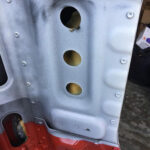
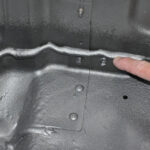
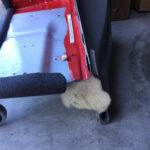
Examples of common foam applications
Images courtesy of John Spoto
Another product used in these applications is NVH material, such as 3M™ NVH Dampening Material PN 04274.
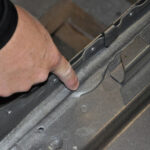
Example of NVH Dampening Material
Image courtesy of John Spoto
This material is designed to be used for replacing or re-installing factory NVH sealants and foams. They can eliminate vibration and reduce noise between panels, braces, and intrusion beams. The NVH Dampening Material performs well in attaching existing foam to panels, filling small gaps where foam cannot be used or easily replaced, and for sealing edges of cut, open, or damaged foam (see picture below).

Image Courtesy of I-CAR
The repair and replacement process should begin by identifying the OEM location of the foams for that specific vehicle make and model. This information should be identified through the OEM website, technical bulletins, and recommended repair procedures. Identify the location and type of foams on the repair vehicle. Inspect the condition of the foam for damaged material that will need to be removed and replaced. Determine the best replacement material based on foam type, cell structure, compression, density, and texture. Foam Flow Rate and Foam Time should also be considered based on the access point and location where the foam is needed. The volume of foam needed can be calculated using the expansion rate of the foam and the volume of the area being filled. Remove any damaged foam, undamaged foam can be left in place. Abrasives, chisels, knives, scrappers, and rolling the foam off by hand are all methods used to remove foams. Heat can be useful to remove undamaged foam for reuse. If welding will be performed in the area, remove all foam, regardless of condition, to reduce the risk of a fire and toxic fumes. Clean and dry the surfaces that will be receiving foam with a water-based and solvent -based cleaner being careful to avoid getting liquid on any existing foam. Prime all bare metal with an epoxy or other approved 2K direct-to-metal primer; never use 1K aerosol primer. Once the primer has dried according to the product data sheet, install the foam. The use of an extension tube may be necessary to access the cavity. A dam may also be needed to hold the foam into a specific area.
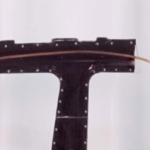
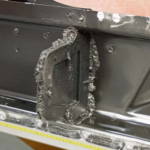
Example of a Dam (Left) and Extension tube being used to increase access (Right)
Images Courtesy of I-CAR
As with any repair process, proper PPE should always be worn. A respirator, chemical resistant gloves, eye and face protection, and a paint suit are all safety equipment that should be used when working with foams and NVH materials. Expandable foams are flammable, caution should be taken, and a fire extinguisher should be available when a heat source is being used near foams.
High quality foams that are designed for the collision repair industry are typically 2-part urethane closed-cell foams. This type of foam is needed to meet OEM performance requirements such as temperature and moisture resistance. Consumer foams that are found at home improvement stores should not be used for vehicle collision repair applications. These foams are typically one-part, open-cell urethane foams that require moisture to cure. If this material is applied to a part or inside a body panel where moisture isn’t present, the foam may never cure and can result in voids or hollow spots.
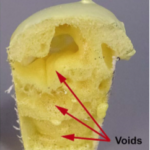
Open cell, consumer foam, Image Courtesy of I-CAR
Being an open-cell foam, this material can absorb and hold moisture which may cause corrosion issues. Another limitation of the consumer foams is vibration resistance, these foams can break down from the excessive vibration found in today’s heavy-duty trucks and commercial vehicles.
Sound deadening pads are another product commonly found on heavy trucks and commercial vehicles. These pads, such as 3M™ Sound Deadening Pads PN 08840, are placed on a variety of interior panels to block and reduce road noise, engine sounds, panel vibration, and other noises.
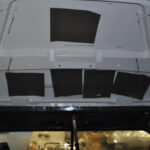
Sound Deadening Pad use in a Truck Cab Roof, Image courtesy of John Spoto
These pads are easy to install (cut to size, peel liner, apply to the surface) and should be replaced as necessary on any collision repair.
Heavy-duty truck and commercial vehicle OEM’s also apply other materials in strategic locations to reduce noise, vibration, and harshness. One example of this would be the “doghouse” area on the cab floor above the transmission (see picture below).
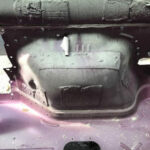
“Doghouse” cab floor area with OEM applied sound deadening materials, Image courtesy of John Spoto
These materials will have a pattern or texture from the OEM application method. The appearance of these materials may be matched during the repair process using products discussed above, or another product such as 3M™ Heavy-Bodied Seam Sealer PN 08308. This product is a two-part epoxy that has NVH properties as well as excellent tooling properties. A variety of tools and materials can be used to manipulate this seam sealer to replicate an OEM appearance. These include:
- Placing notches in an adhesive spreader and running it over the seam sealer to match a linear pattern. A comb could also be used
- Dabbing the surface of the seam sealer with a 3M™ScotchBrite pad is another method that can be used to match an OEM texture.
- Utilizing the seam sealer gun in a push/pull or side-to-side method can produce a specific pattern as well.
Using these products and a little creativity, many of these OEM textured surfaces can be matched very effectively.
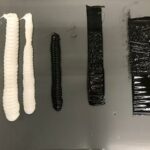
Samples of textures reproduced using seam sealer
Image courtesy of Todd Matthes
Conclusion
The products and processes to inspect, repair, and replace foams, NVH material, and sound deadening pads are an important part of performing a quality repair. IMPORTANT NOTE: There are of course many factors and variables that can affect an individual repair, so the technician and repair facility should evaluate each specific application and repair process, including relevant vehicle, part and OEM guidelines, and determine what is appropriate for the repair. For more Heavy-Duty Truck and Commercial Vehicle Collision Repair product information, Standard Operating Procedures, and Videos, please visit our website at 3M.com/truck.
